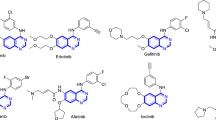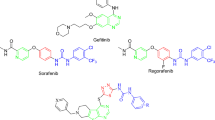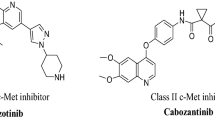Abstract
A series of analogs of vegfrecine, a natural quinone vascular endothelial growth factor receptor (VEGFR) tyrosine kinase inhibitor, was synthesized via oxidative amination of 2,5-dihydroxybenzamide with functionalized arylamine followed by ammonolysis and substitution of the quinone ring. The inhibitory activities of the analogs against the VEGFR-1 and -2 tyrosine kinases were assayed in vitro with the aim to identify a compound suitable to treat cancer and inflammatory diseases. Alterations of the functionality of the phenyl group, substitution of the quinone ring, and oxidative cyclization of the 1-carboxamide-2-aminoquinone moiety to form an isoxazole quinone ring were examined. Introduction of halo- and alkyl-substituents at the 5′-position of the phenyl ring resulted in potent inhibition of the VEGFR-1 and -2 tyrosine kinases. In particular, structural modification at C-5′ on the phenyl ring was shown to significantly affect the selectivity of the inhibition between the VEGFR-1 and -2 tyrosine kinases. Compound 8, 5′-methyl-vegfrecine, showed superior selectivity toward the VEGFR-2 tyrosine kinase over the VEGFR-1 tyrosine kinase.
This is a preview of subscription content, access via your institution
Access options
Subscribe to this journal
Receive 12 print issues and online access
$259.00 per year
only $21.58 per issue
Buy this article
- Purchase on Springer Link
- Instant access to full article PDF
Prices may be subject to local taxes which are calculated during checkout



Similar content being viewed by others
References
Carmeliet P, et al. Role of tissue factor in embryonic blood vessel development. Nature. 1996;383:73–5.
Ferrara N, et al. Heterozygous embryonic lethality induced by targeted inactivation of the VEGF gene. Nature. 1996;380:439–42.
Mustonen T, Alitalo K. Endothelial receptor tyrosine kinases involved in angiogenesis. J Cell Biol. 1995;129:895–8.
Risau W. Mechanisms of angiogenesis. Nature. 1997;386:671–4.
Costa C, Incio J, Soares R. Angiogenesis and chronic inflammation: cause or consequence? Angiogenesis. 2007;10:149–66.
Elshabrawy HA, Chen Z, Volin MV, Ravella S, Virupannavar S, Shahrara S. The pathogenic role of angiogenesis in rheumatoid arthritis. Angiogenesis. 2015;18:433–48.
Dorrell M, Uusitalo-Jarvinen H, Aguilar E, Friedlander M. Ocular neovascularization: basic mechanisms and therapeutic advances. Surv Ophthalmol. 2007;52:S3–19.
Creamer D, Sullivan D, Bicknell R, Barker J. Angiogenesis in psoriasis. Angiogenesis. 2002;5:231–6.
Folkman J. Role of angiogenesis in tumor growth and metastasis. Semin Oncol. 2002;29 Suppl 16:15–8.
Eichmann A, Marcelle C, Breant C, Le Douarin NM. Two molecules related to the VEGF receptor are expressed in early endothelial cells during avian embryonic development. Mech Dev. 1993;42:33–48.
Jakeman LB, Winer J, Bennett GL, Altar CA, Ferrara N. Binding sites for vascular endothelial growth factor are localized on endothelial cells in adult rat tissues. J Clin Investig. 1992;89:244–53.
Kaipainen A, et al. The related FLT4, FLT1, and KDR receptor tyrosine kinases show distinct expression patterns in human fetal endothelial cells. J Exp Med. 1993;178:2077–88.
Yamane A, et al. A new communication system between hepatocytes and sinusoidal endothelial cells in liver through vascular endothelial growth factor and Flt tyrosine kinase receptor family (Flt-1 and KDR/Flk-1). Oncogene. 1994;9:2683–90.
Adams J, Huang P, Patrick D. A strategy for the design of multiplex inhibitors for kinase-mediated signalling in angiogenesis. Curr Opin Chem Biol. 2002;6:486–92.
Boyer SJ. Small molecule inhibitors of KDR (VEGFR-2) kinase: an overview of structure activity relationships. Curr Top Med Chem. 2002;2:973–1000.
Sun L, McMahon G. Inhibition of tumor angiogenesis by synthetic receptor tyrosine kinase inhibitors. Drug Discov Today. 2000;5:344–53.
Veikkola T, Karkkainen M, Claesson-Welsh L, Alitalo K. Regulation of angiogenesis via vascular endothelial growth factor receptors. Cancer Res. 2000;60:203–12.
Waltenberger J, Claesson-Welsh L, Siegbahn A, Shibuya M, Heldin CH. Different signal transduction properties of KDR and Flt1, two receptors for vascular endothelial growth factor. J Biol Chem. 1994;269:26988–95.
Adini A, Kornaga T, Firoozbakht F, Benjamin LE. Placental growth factor is a survival factor for tumor endothelial cells and macrophages. Cancer Res. 2002;62:2749–52.
Hiratsuka S, Maru Y, Okada A, Seiki M, Noda T, Shibuya M. Involvement of Flt-1 tyrosine kinase (vascular endothelial growth factor receptor-1) in pathological angiogenesis. Cancer Res. 2001;61:1207–13.
Luttun A, et al. Revascularization of ischemic tissues by PlGF treatment, and inhibition of tumor angiogenesis, arthritis and atherosclerosis by anti-Flt1. Nat Med. 2002;8:831–40.
Lyden D, et al. Impaired recruitment of bone-marrow-derived endothelial and hematopoietic precursor cells blocks tumor angiogenesis and growth. Nat Med. 2001;7:1194–201.
Sawano A, et al. Flt-1, vascular endothelial growth factor receptor 1, is a novel cell surface marker for the lineage of monocyte-macrophages in humans. Blood. 2001;97:785–91.
Choi ST, Kim JH, Seok JY, Park YB, Lee SK. Therapeutic effect of anti-vascular endothelial growth factor receptor I antibody in the established collagen-induced arthritis mouse model. Clin Rheumatol. 2009;28:333–7.
De Bandt M, et al. Blockade of vascular endothelial growth factor receptor I (VEGF-RI), but not VEGF-RII, suppresses joint destruction in the K/BxN model of rheumatoid arthritis. J Immunol. 2003;171:4853–9.
Shibuya M. Vascular endothelial growth factor receptor-1 (VEGFR-1/Flt-1, a dual regulator for angiogenesis. Angiogenesis. 2006;9:225–30. discussion 231.
Wu Y, et al. Anti-vascular endothelial growth factor receptor-1 antagonist antibody as a therapeutic agent for cancer. Clin Cancer Res. 2006;12:6573–84.
Yin B, Fang DM, Zhou XL, Gao F. Natural products as important tyrosine kinase inhibitors. Eur J Med Chem. 2019;182:111664.
Pan CC, et al. Angiostatic actions of capsicodendrin through selective inhibition of VEGFR2-mediated AKT signaling and disregulated autophagy. Oncotarget. 2017;8:12675–85.
Shen S, Xu X, Liu Z, Liu J, Hu L. Synthesis and structure-activity relationships of boswellic acid derivatives as potent VEGFR-2 inhibitors. Bioorg Med Chem. 2015;23:1982–93.
Kimura Y, Sumiyoshi M, Baba K. Anti-tumor actions of major component 3’-O-acetylhamaudol of Angelica japonica roots through dual actions, anti-angiogenesis and intestinal intraepithelial lymphocyte activation. Cancer Lett. 2008;265:84–97.
Li Q, et al. Screening bioactive compounds from Ligusticum chuanxiong by high density immobilized human umbilical vein endothelial cells. Anal Bioanal Chem. 2015;407:5783–92.
Hailat MM, Ebrahim HY, Mohyeldin MM, Goda AA, Siddique AB, El, et al. The tobacco cembranoid (1S,2E,4S,7E,11E)-2,7,11-cembratriene-4,6-diol as a novel angiogenesis inhibitory lead for the control of breast malignancies. Bioorg Med Chem. 2017;25:3911–21.
Lu K, Basu S. The natural compound chebulagic acid inhibits vascular endothelial growth factor A mediated regulation of endothelial cell functions. Sci Rep. 2015;5:9642.
Nosaka C, et al. Vegfrecine, an inhibitor of VEGF receptor tyrosine kinases isolated from the culture broth of Streptomyces sp. J Nat Prod. 2013;76:715–9.
Adachi H, et al. Microbial metabolites and derivatives targeted at inflammation and bone diseases therapy: chemistry, biological activity and pharmacology. J Antibiot. 2018;71:60–71.
Niedermeyer THJ, Mikolasch A, Lalk M. Nuclear Amination catalyzed by fungal laccases: Reaction products of p-hydroquinones and primary aromatic amines. J Org Chem. 2005;70:2002–8.
Itokawa T, et al. Antiangiogenic effect by SU5416 is partly attributable to inhibition of Flt-1 receptor signaling. Mol Cancer Ther. 2002;1:295–302.
Diazgarcia MA, et al. Synthesis and 2nd-order nonlinear-optical properties of substituted aminobenzoquinones. J Mater Chem. 1995;5:385–7.
Chen SP, Li XM, Wan SB, Jiang T. Synthesis of novel benzoxazinone compounds as epidermal growth factor receptor (Egfr) tyrosine kinase inhibitors. Synth Commun. 2012;42:2937–46.
Stahl P, Kissau L, Mazitschek R, Giannis A, Waldmann H. Natural product derived receptor tyrosine kinase inhibitors: identification of IGF1R, Tie-2, and VEGFR-3 inhibitors. Angew Chem Int Ed. 2002;41:1174–8.
Acknowledgements
We thank Dr. Masatomi Iijima and Dr. Isao Momose for mass spectral determinations.
Author information
Authors and Affiliations
Corresponding author
Ethics declarations
Conflict of interest
The authors declare no competing interests.
Additional information
Publisher’s note Springer Nature remains neutral with regard to jurisdictional claims in published maps and institutional affiliations.
Rights and permissions
About this article
Cite this article
Adachi, H., Nosaka, C., Atsumi, S. et al. Structure-activity relationships of natural quinone vegfrecine analogs with potent activity against VEGFR-1 and -2 tyrosine kinases. J Antibiot 74, 734–742 (2021). https://doi.org/10.1038/s41429-021-00445-y
Received:
Revised:
Accepted:
Published:
Issue Date:
DOI: https://doi.org/10.1038/s41429-021-00445-y



